Welfare Systems and Policies in Australia
VerifiedAdded on 2023/06/03
|6
|1468
|455
AI Summary
This article discusses the welfare systems and policies in Australia, including Medicare, Centrelink, and Veteran Affairs. It explains how these programs work and their impact on citizens' lives. The article also highlights the importance of the universal health care system in Australia and its positive effects on the country's economy and life expectancy.
Contribute Materials
Your contribution can guide someone’s learning journey. Share your
documents today.
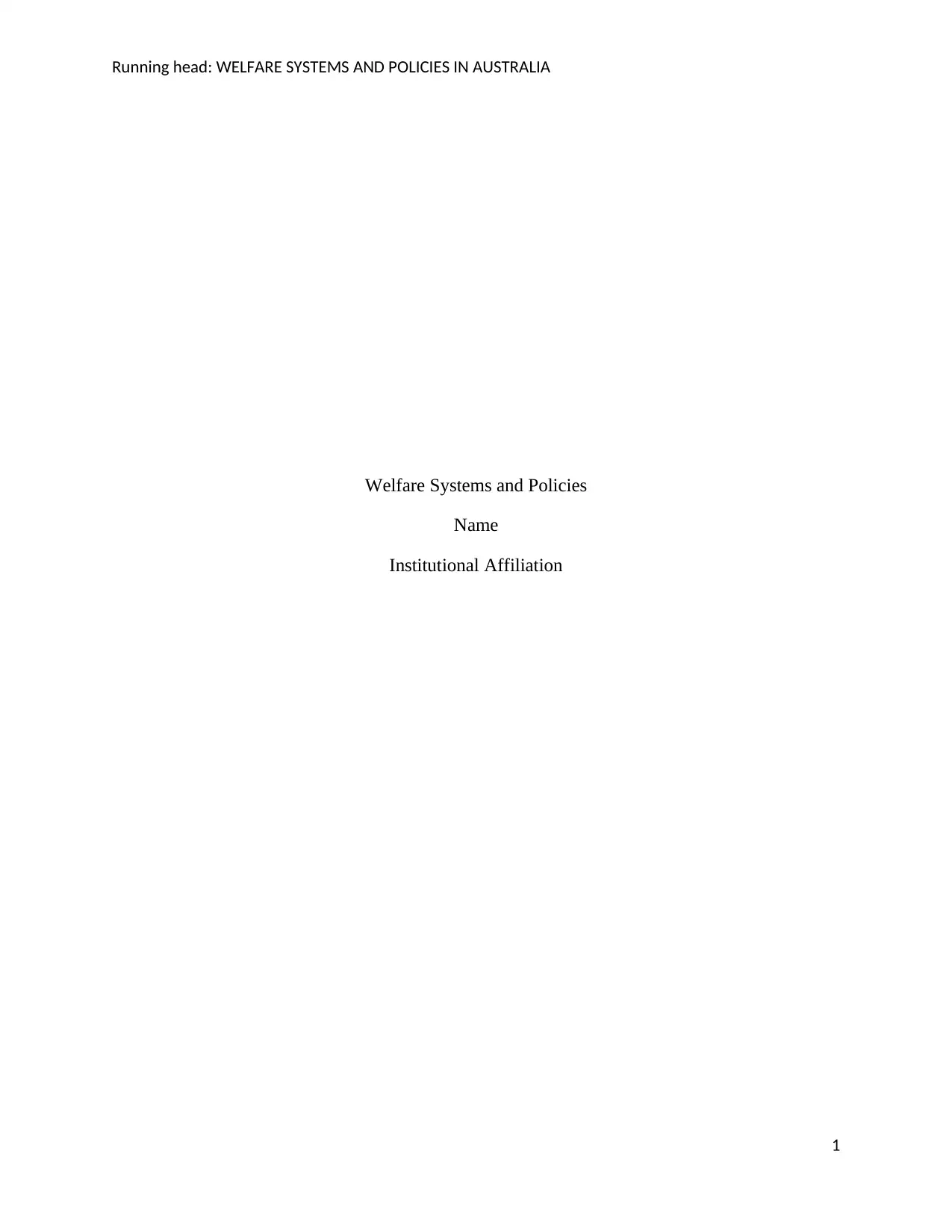
Running head: WELFARE SYSTEMS AND POLICIES IN AUSTRALIA
Welfare Systems and Policies
Name
Institutional Affiliation
1
Welfare Systems and Policies
Name
Institutional Affiliation
1
Secure Best Marks with AI Grader
Need help grading? Try our AI Grader for instant feedback on your assignments.
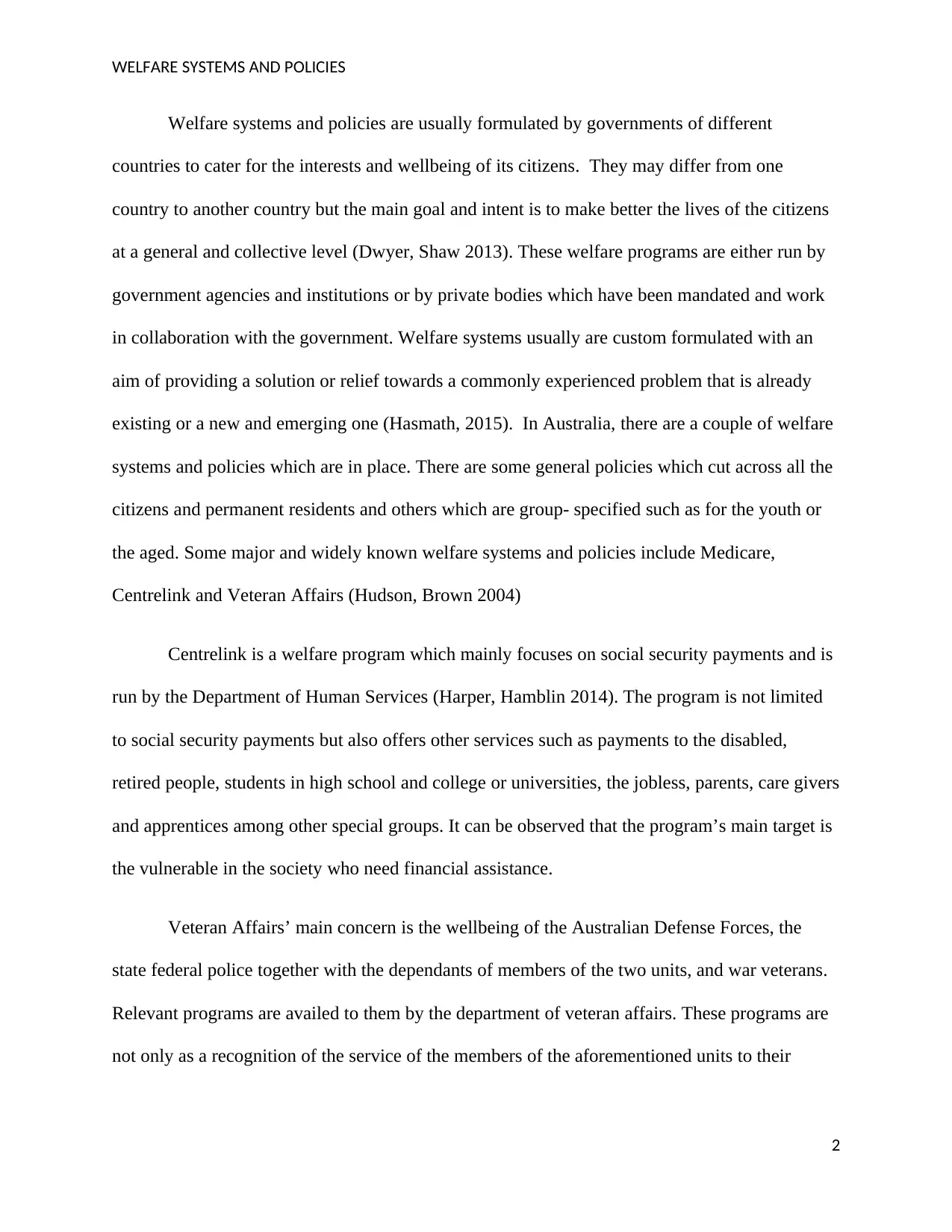
WELFARE SYSTEMS AND POLICIES
Welfare systems and policies are usually formulated by governments of different
countries to cater for the interests and wellbeing of its citizens. They may differ from one
country to another country but the main goal and intent is to make better the lives of the citizens
at a general and collective level (Dwyer, Shaw 2013). These welfare programs are either run by
government agencies and institutions or by private bodies which have been mandated and work
in collaboration with the government. Welfare systems usually are custom formulated with an
aim of providing a solution or relief towards a commonly experienced problem that is already
existing or a new and emerging one (Hasmath, 2015). In Australia, there are a couple of welfare
systems and policies which are in place. There are some general policies which cut across all the
citizens and permanent residents and others which are group- specified such as for the youth or
the aged. Some major and widely known welfare systems and policies include Medicare,
Centrelink and Veteran Affairs (Hudson, Brown 2004)
Centrelink is a welfare program which mainly focuses on social security payments and is
run by the Department of Human Services (Harper, Hamblin 2014). The program is not limited
to social security payments but also offers other services such as payments to the disabled,
retired people, students in high school and college or universities, the jobless, parents, care givers
and apprentices among other special groups. It can be observed that the program’s main target is
the vulnerable in the society who need financial assistance.
Veteran Affairs’ main concern is the wellbeing of the Australian Defense Forces, the
state federal police together with the dependants of members of the two units, and war veterans.
Relevant programs are availed to them by the department of veteran affairs. These programs are
not only as a recognition of the service of the members of the aforementioned units to their
2
Welfare systems and policies are usually formulated by governments of different
countries to cater for the interests and wellbeing of its citizens. They may differ from one
country to another country but the main goal and intent is to make better the lives of the citizens
at a general and collective level (Dwyer, Shaw 2013). These welfare programs are either run by
government agencies and institutions or by private bodies which have been mandated and work
in collaboration with the government. Welfare systems usually are custom formulated with an
aim of providing a solution or relief towards a commonly experienced problem that is already
existing or a new and emerging one (Hasmath, 2015). In Australia, there are a couple of welfare
systems and policies which are in place. There are some general policies which cut across all the
citizens and permanent residents and others which are group- specified such as for the youth or
the aged. Some major and widely known welfare systems and policies include Medicare,
Centrelink and Veteran Affairs (Hudson, Brown 2004)
Centrelink is a welfare program which mainly focuses on social security payments and is
run by the Department of Human Services (Harper, Hamblin 2014). The program is not limited
to social security payments but also offers other services such as payments to the disabled,
retired people, students in high school and college or universities, the jobless, parents, care givers
and apprentices among other special groups. It can be observed that the program’s main target is
the vulnerable in the society who need financial assistance.
Veteran Affairs’ main concern is the wellbeing of the Australian Defense Forces, the
state federal police together with the dependants of members of the two units, and war veterans.
Relevant programs are availed to them by the department of veteran affairs. These programs are
not only as a recognition of the service of the members of the aforementioned units to their
2
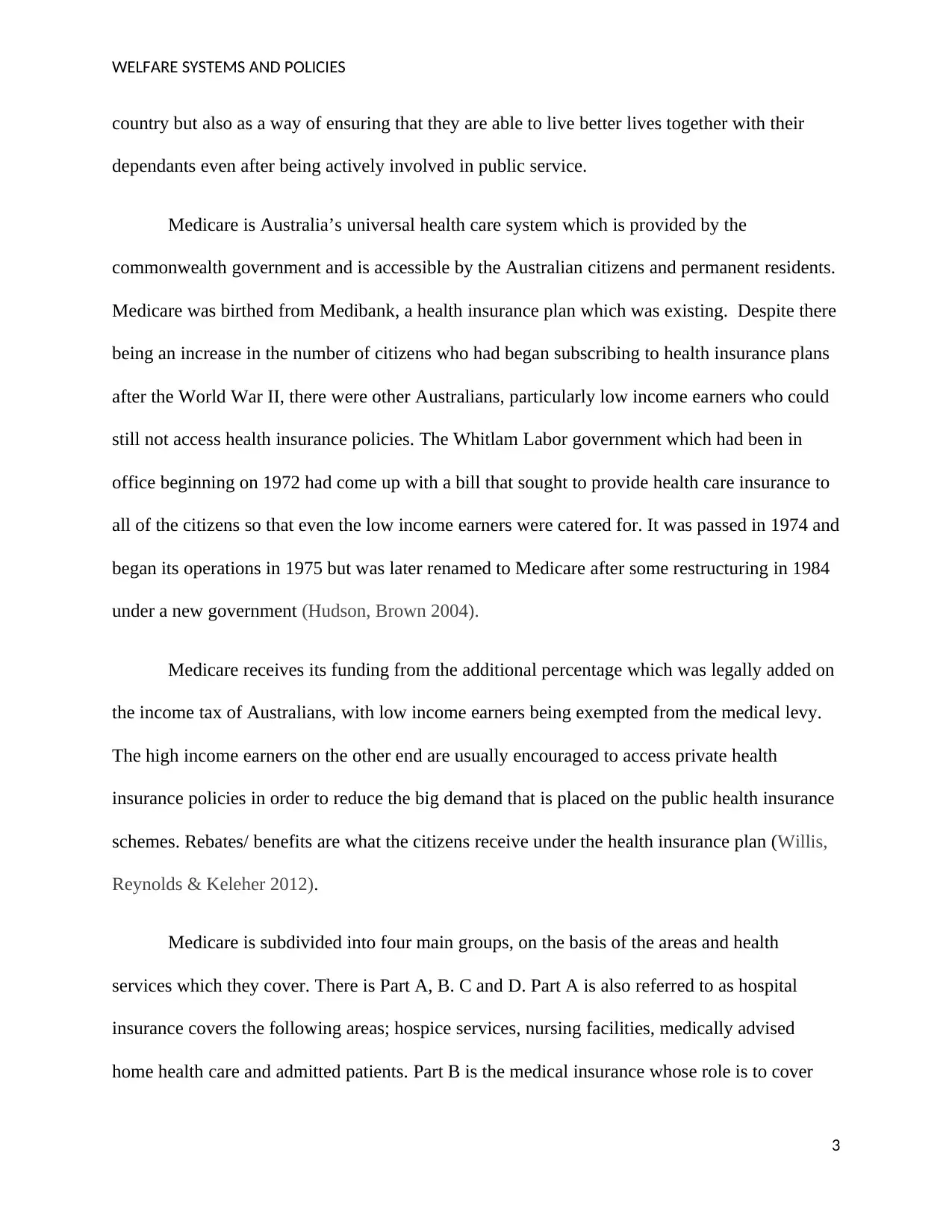
WELFARE SYSTEMS AND POLICIES
country but also as a way of ensuring that they are able to live better lives together with their
dependants even after being actively involved in public service.
Medicare is Australia’s universal health care system which is provided by the
commonwealth government and is accessible by the Australian citizens and permanent residents.
Medicare was birthed from Medibank, a health insurance plan which was existing. Despite there
being an increase in the number of citizens who had began subscribing to health insurance plans
after the World War II, there were other Australians, particularly low income earners who could
still not access health insurance policies. The Whitlam Labor government which had been in
office beginning on 1972 had come up with a bill that sought to provide health care insurance to
all of the citizens so that even the low income earners were catered for. It was passed in 1974 and
began its operations in 1975 but was later renamed to Medicare after some restructuring in 1984
under a new government (Hudson, Brown 2004).
Medicare receives its funding from the additional percentage which was legally added on
the income tax of Australians, with low income earners being exempted from the medical levy.
The high income earners on the other end are usually encouraged to access private health
insurance policies in order to reduce the big demand that is placed on the public health insurance
schemes. Rebates/ benefits are what the citizens receive under the health insurance plan (Willis,
Reynolds & Keleher 2012).
Medicare is subdivided into four main groups, on the basis of the areas and health
services which they cover. There is Part A, B. C and D. Part A is also referred to as hospital
insurance covers the following areas; hospice services, nursing facilities, medically advised
home health care and admitted patients. Part B is the medical insurance whose role is to cover
3
country but also as a way of ensuring that they are able to live better lives together with their
dependants even after being actively involved in public service.
Medicare is Australia’s universal health care system which is provided by the
commonwealth government and is accessible by the Australian citizens and permanent residents.
Medicare was birthed from Medibank, a health insurance plan which was existing. Despite there
being an increase in the number of citizens who had began subscribing to health insurance plans
after the World War II, there were other Australians, particularly low income earners who could
still not access health insurance policies. The Whitlam Labor government which had been in
office beginning on 1972 had come up with a bill that sought to provide health care insurance to
all of the citizens so that even the low income earners were catered for. It was passed in 1974 and
began its operations in 1975 but was later renamed to Medicare after some restructuring in 1984
under a new government (Hudson, Brown 2004).
Medicare receives its funding from the additional percentage which was legally added on
the income tax of Australians, with low income earners being exempted from the medical levy.
The high income earners on the other end are usually encouraged to access private health
insurance policies in order to reduce the big demand that is placed on the public health insurance
schemes. Rebates/ benefits are what the citizens receive under the health insurance plan (Willis,
Reynolds & Keleher 2012).
Medicare is subdivided into four main groups, on the basis of the areas and health
services which they cover. There is Part A, B. C and D. Part A is also referred to as hospital
insurance covers the following areas; hospice services, nursing facilities, medically advised
home health care and admitted patients. Part B is the medical insurance whose role is to cover
3
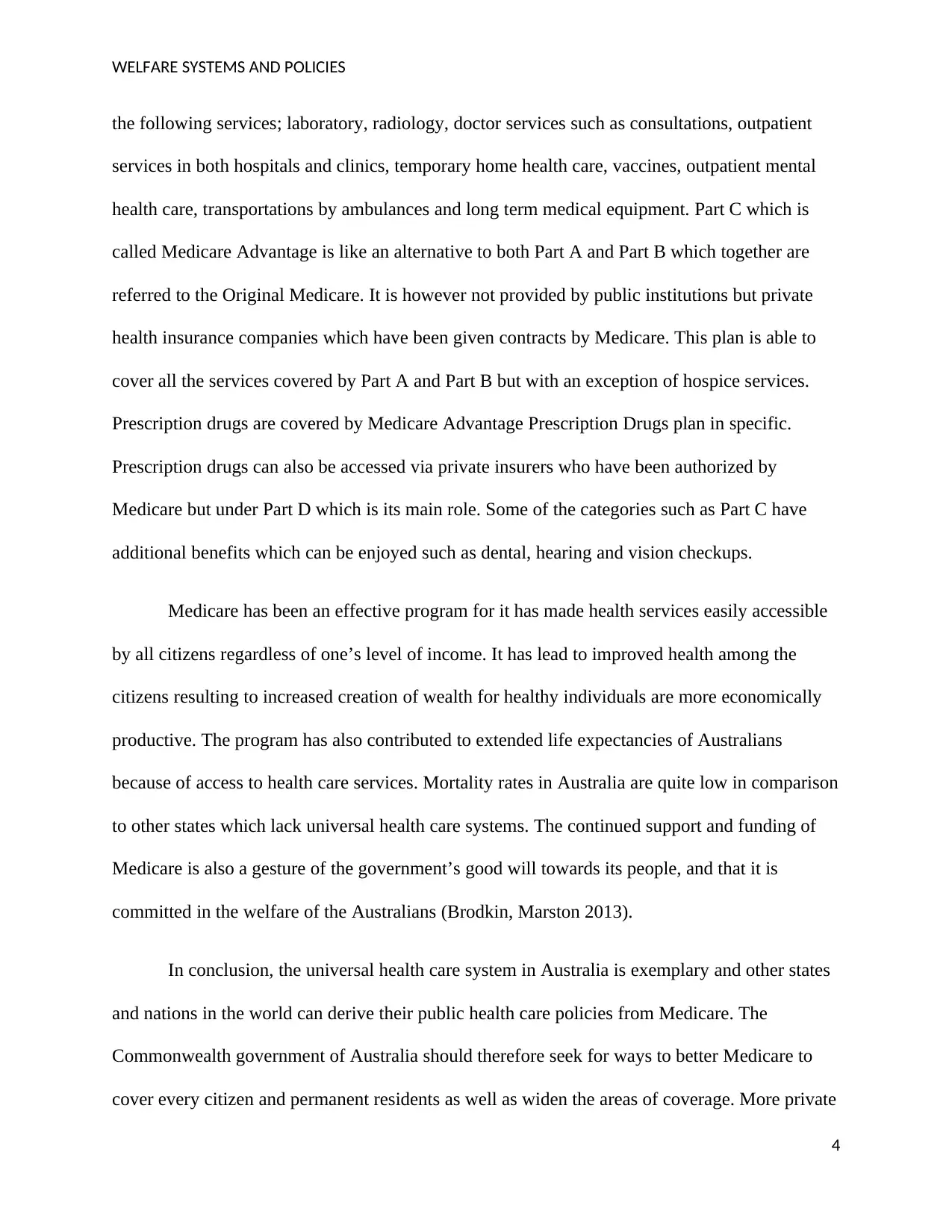
WELFARE SYSTEMS AND POLICIES
the following services; laboratory, radiology, doctor services such as consultations, outpatient
services in both hospitals and clinics, temporary home health care, vaccines, outpatient mental
health care, transportations by ambulances and long term medical equipment. Part C which is
called Medicare Advantage is like an alternative to both Part A and Part B which together are
referred to the Original Medicare. It is however not provided by public institutions but private
health insurance companies which have been given contracts by Medicare. This plan is able to
cover all the services covered by Part A and Part B but with an exception of hospice services.
Prescription drugs are covered by Medicare Advantage Prescription Drugs plan in specific.
Prescription drugs can also be accessed via private insurers who have been authorized by
Medicare but under Part D which is its main role. Some of the categories such as Part C have
additional benefits which can be enjoyed such as dental, hearing and vision checkups.
Medicare has been an effective program for it has made health services easily accessible
by all citizens regardless of one’s level of income. It has lead to improved health among the
citizens resulting to increased creation of wealth for healthy individuals are more economically
productive. The program has also contributed to extended life expectancies of Australians
because of access to health care services. Mortality rates in Australia are quite low in comparison
to other states which lack universal health care systems. The continued support and funding of
Medicare is also a gesture of the government’s good will towards its people, and that it is
committed in the welfare of the Australians (Brodkin, Marston 2013).
In conclusion, the universal health care system in Australia is exemplary and other states
and nations in the world can derive their public health care policies from Medicare. The
Commonwealth government of Australia should therefore seek for ways to better Medicare to
cover every citizen and permanent residents as well as widen the areas of coverage. More private
4
the following services; laboratory, radiology, doctor services such as consultations, outpatient
services in both hospitals and clinics, temporary home health care, vaccines, outpatient mental
health care, transportations by ambulances and long term medical equipment. Part C which is
called Medicare Advantage is like an alternative to both Part A and Part B which together are
referred to the Original Medicare. It is however not provided by public institutions but private
health insurance companies which have been given contracts by Medicare. This plan is able to
cover all the services covered by Part A and Part B but with an exception of hospice services.
Prescription drugs are covered by Medicare Advantage Prescription Drugs plan in specific.
Prescription drugs can also be accessed via private insurers who have been authorized by
Medicare but under Part D which is its main role. Some of the categories such as Part C have
additional benefits which can be enjoyed such as dental, hearing and vision checkups.
Medicare has been an effective program for it has made health services easily accessible
by all citizens regardless of one’s level of income. It has lead to improved health among the
citizens resulting to increased creation of wealth for healthy individuals are more economically
productive. The program has also contributed to extended life expectancies of Australians
because of access to health care services. Mortality rates in Australia are quite low in comparison
to other states which lack universal health care systems. The continued support and funding of
Medicare is also a gesture of the government’s good will towards its people, and that it is
committed in the welfare of the Australians (Brodkin, Marston 2013).
In conclusion, the universal health care system in Australia is exemplary and other states
and nations in the world can derive their public health care policies from Medicare. The
Commonwealth government of Australia should therefore seek for ways to better Medicare to
cover every citizen and permanent residents as well as widen the areas of coverage. More private
4
Secure Best Marks with AI Grader
Need help grading? Try our AI Grader for instant feedback on your assignments.
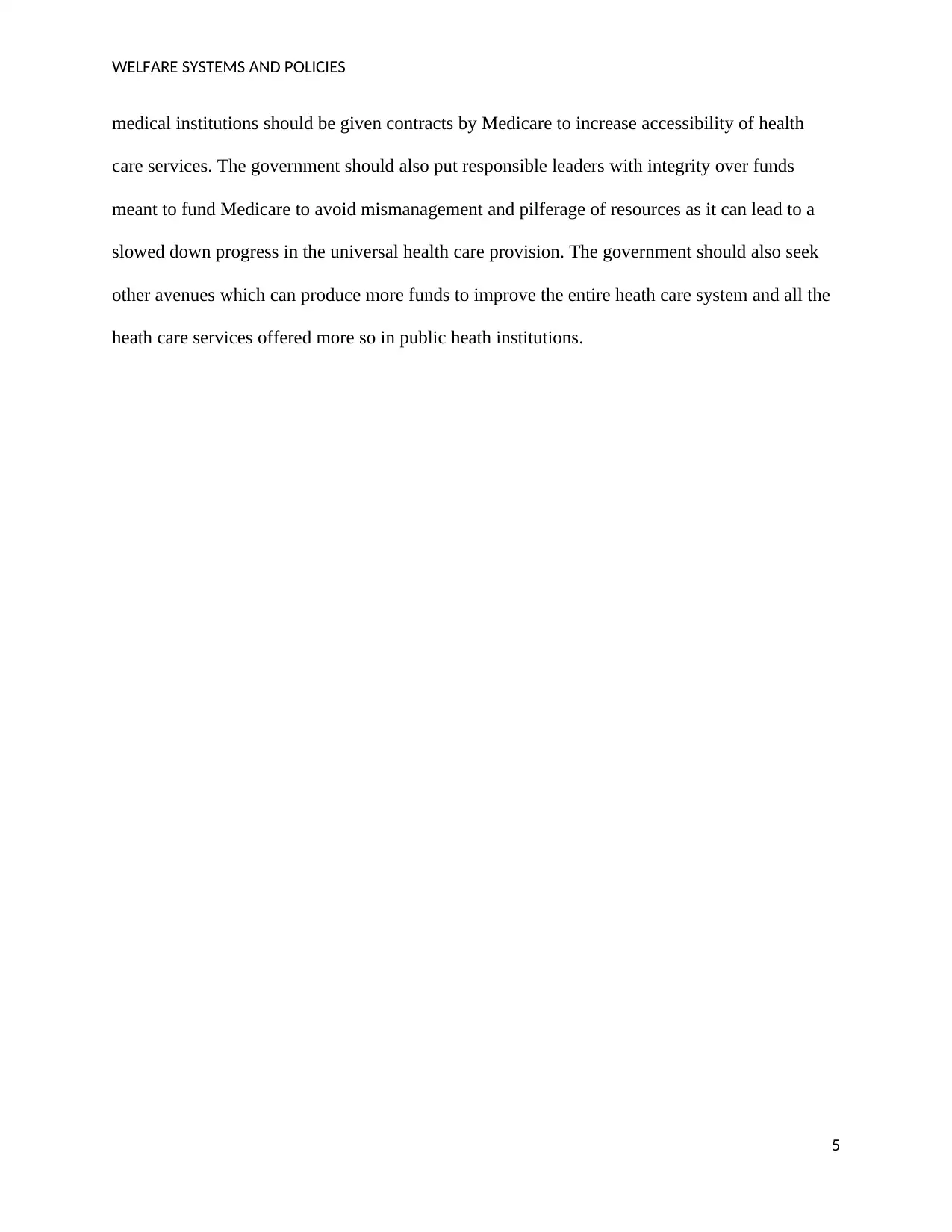
WELFARE SYSTEMS AND POLICIES
medical institutions should be given contracts by Medicare to increase accessibility of health
care services. The government should also put responsible leaders with integrity over funds
meant to fund Medicare to avoid mismanagement and pilferage of resources as it can lead to a
slowed down progress in the universal health care provision. The government should also seek
other avenues which can produce more funds to improve the entire heath care system and all the
heath care services offered more so in public heath institutions.
5
medical institutions should be given contracts by Medicare to increase accessibility of health
care services. The government should also put responsible leaders with integrity over funds
meant to fund Medicare to avoid mismanagement and pilferage of resources as it can lead to a
slowed down progress in the universal health care provision. The government should also seek
other avenues which can produce more funds to improve the entire heath care system and all the
heath care services offered more so in public heath institutions.
5
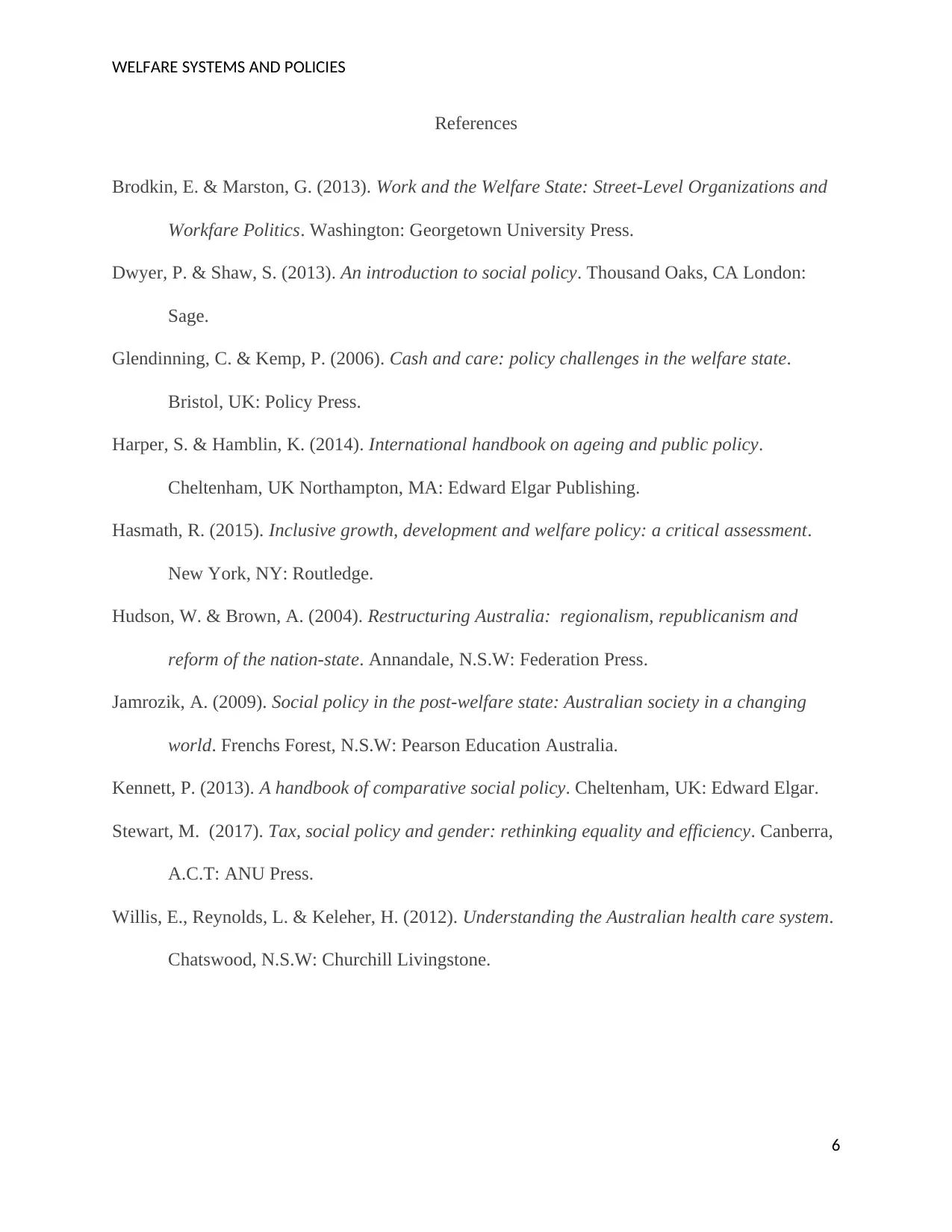
WELFARE SYSTEMS AND POLICIES
References
Brodkin, E. & Marston, G. (2013). Work and the Welfare State: Street-Level Organizations and
Workfare Politics. Washington: Georgetown University Press.
Dwyer, P. & Shaw, S. (2013). An introduction to social policy. Thousand Oaks, CA London:
Sage.
Glendinning, C. & Kemp, P. (2006). Cash and care: policy challenges in the welfare state.
Bristol, UK: Policy Press.
Harper, S. & Hamblin, K. (2014). International handbook on ageing and public policy.
Cheltenham, UK Northampton, MA: Edward Elgar Publishing.
Hasmath, R. (2015). Inclusive growth, development and welfare policy: a critical assessment.
New York, NY: Routledge.
Hudson, W. & Brown, A. (2004). Restructuring Australia: regionalism, republicanism and
reform of the nation-state. Annandale, N.S.W: Federation Press.
Jamrozik, A. (2009). Social policy in the post-welfare state: Australian society in a changing
world. Frenchs Forest, N.S.W: Pearson Education Australia.
Kennett, P. (2013). A handbook of comparative social policy. Cheltenham, UK: Edward Elgar.
Stewart, M. (2017). Tax, social policy and gender: rethinking equality and efficiency. Canberra,
A.C.T: ANU Press.
Willis, E., Reynolds, L. & Keleher, H. (2012). Understanding the Australian health care system.
Chatswood, N.S.W: Churchill Livingstone.
6
References
Brodkin, E. & Marston, G. (2013). Work and the Welfare State: Street-Level Organizations and
Workfare Politics. Washington: Georgetown University Press.
Dwyer, P. & Shaw, S. (2013). An introduction to social policy. Thousand Oaks, CA London:
Sage.
Glendinning, C. & Kemp, P. (2006). Cash and care: policy challenges in the welfare state.
Bristol, UK: Policy Press.
Harper, S. & Hamblin, K. (2014). International handbook on ageing and public policy.
Cheltenham, UK Northampton, MA: Edward Elgar Publishing.
Hasmath, R. (2015). Inclusive growth, development and welfare policy: a critical assessment.
New York, NY: Routledge.
Hudson, W. & Brown, A. (2004). Restructuring Australia: regionalism, republicanism and
reform of the nation-state. Annandale, N.S.W: Federation Press.
Jamrozik, A. (2009). Social policy in the post-welfare state: Australian society in a changing
world. Frenchs Forest, N.S.W: Pearson Education Australia.
Kennett, P. (2013). A handbook of comparative social policy. Cheltenham, UK: Edward Elgar.
Stewart, M. (2017). Tax, social policy and gender: rethinking equality and efficiency. Canberra,
A.C.T: ANU Press.
Willis, E., Reynolds, L. & Keleher, H. (2012). Understanding the Australian health care system.
Chatswood, N.S.W: Churchill Livingstone.
6
1 out of 6
Related Documents
Your All-in-One AI-Powered Toolkit for Academic Success.
+13062052269
info@desklib.com
Available 24*7 on WhatsApp / Email
![[object Object]](/_next/static/media/star-bottom.7253800d.svg)
Unlock your academic potential
© 2024 | Zucol Services PVT LTD | All rights reserved.





